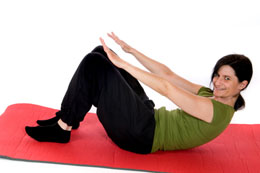Spinal stenosis is narrowing of the spinal canal, which may be caused due to overgrowth of bone or due to a herniated disc. This condition is seen in many middle aged, as well as young people. The following article provides information about the various exercises to help get rid of this medical condition.

Aging brings in many changes in man. The physical health of a person goes on deteriorating, which may lead to loss of flexibility, muscle pain, joint pain, slow bodily movements, etc. One such condition that develops with aging is spinal stenosis.
What is Spinal Stenosis?
Spinal stenosis may be defined as a condition associated with the narrowing of the spinal canal situated mostly in the areas of upper and lower back. This narrowing of the spine exerts a lot of pressure on the spinal cord and nerves, thereby causing pain in that area. This condition occurs mostly in the spine of either of the three areas; thoracic, cervical, or lumbar. It develops due to spinal degeneration that takes place due to aging. In some cases, osteoporosis, tumor, or spinal disc herniation may also cause this condition. The symptoms of this narrowing of the spinal canal normally goes unnoticed in the beginning. They develop slowly without causing too much of pain. However, the condition aggravates further causing severe pain and restrictions on body movements. Some of the symptoms observed in this condition are numbness in hands, legs, arms, neck, or shoulders. In some cases, cramping is also observed.
Exercises
This condition decreases the flexibility, as well as the strength of your spinal cord. Therefore some exercises are necessary that would target both the concerns.
Flexibility Exercises:
- Exercise # 1: This is one of the most effective back exercises for this condition. Stand straight, with your hands placed on your hips. Now, bend backwards so that you feel a good and comfortable stretch in your back. Maintain this position for about 4-5 seconds and perform about 5 repetitions.
- Exercise # 2: Lie flat on your back. Raise either of your legs and support the back of the thigh with your hands. Try to straighten your knee to feel a comfortable stretch in the back of the thigh. Hold this position for about 30 seconds and then repeat with the other leg. Perform around 2-3 repetitions with each leg.
Strengthening Exercises:
- Exercises # 1: Lie down flat on your stomach with your arms sideways. Tighten your buttocks and raise your head and shoulders as much as you can. Maintain this position for about 4-5 seconds and repeat 8-10 times.
- Exercise # 2: Lie flat on your back, with your arms at sides. Now, bend your knees and also tilt your pelvis, so that your back is flattened. Lift your head and shoulders, until your shoulder blades are completely raised above the floor. Remain in this position for about 4-5 seconds and perform 8-10 repetitions.
Lumbar Exercises:
Lumbar spinal stenosis is a condition characterized by the narrowing of lumbar spine which causes lower back pain, sciatica, buttock pain, etc. Some exercises for this condition are:
- Exercise #1: Stand straight and start marching in the same place. While marching, make sure that you lift your legs 4-5 inches above the ground. Perform the first set for about a minute or so, and then repeat for another couple of times.
- Exercise #2: Lie flat on your stomach. Lift your left hand and left leg at about 2-3 inches above the floor. Hold this position for a few seconds, and then repeat with the other side. Perform 2-3 repetitions with each side.
While doing any of the aforementioned exercises, make sure that you do not stretch or bent any of your body part beyond your comfort level. Overstretching might worsen the situation. If the pain persists even after performing regular exercises, then consult a specialist and get appropriate medications.
Disclaimer:
This article is for informative purposes only and does not in any way attempt to replace the advice offered by an expert on the subject.


 Aging brings in many changes in man. The physical health of a person goes on deteriorating, which may lead to loss of flexibility, muscle pain, joint pain, slow bodily movements, etc. One such condition that develops with aging is spinal stenosis.
Aging brings in many changes in man. The physical health of a person goes on deteriorating, which may lead to loss of flexibility, muscle pain, joint pain, slow bodily movements, etc. One such condition that develops with aging is spinal stenosis.